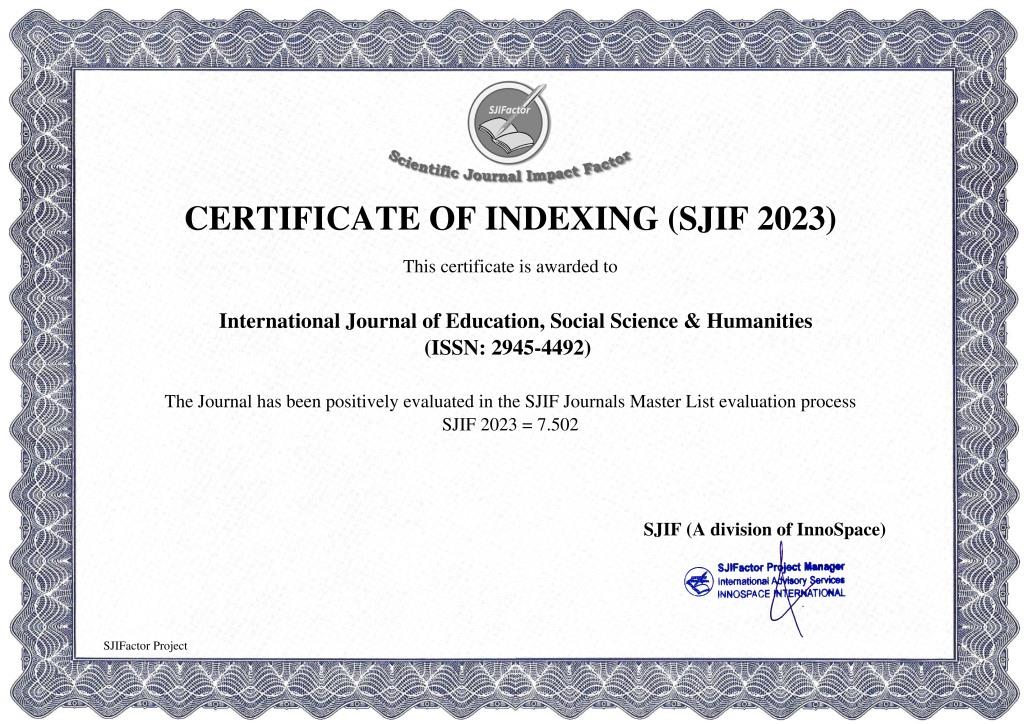NOVERBAL FORM OF LANGUAGE OCULEZIKA-EYE LANGUAGE
Keywords:
eye gaze, audience effect, interpersonal dynamics, social interaction, autismAbstract
Social interactions involve complex exchanges of a variety of social signals, such as gaze, facial expressions, speech and gestures. Focusing on the dual function of eye gaze, this review explores how the presence of an audience, communicative purpose and temporal dynamics of gaze allow interacting partners to achieve successful communication. First, we focus on how being watched modulates social cognition and behavior. We then show that the study of interpersonal gaze processing, particularly gaze temporal dynamics, can provide valuable understanding of social behavior in real interactions. We propose that the Interpersonal Gaze Processing model, which combines both sensing and signaling functions of eye gaze, provides a framework to make sense of gaze patterns in live interactions. Finally, we discuss how autistic individuals process the belief in being watched and interpersonal dynamics of gaze, and suggest that systematic manipulation of factors modulating gaze signaling can reveal which aspects of social eye gaze are challenging in autism.
References
American Psychological Association (2013). Diagnostic and Statistical Manual of Mental Disorders, 5th Edn. Washington, DC: American Psychological Association; 10.1176/appi.books.9780890425596 [CrossRef] [Google Scholar]
Argyle M., Dean J. (1965). Eye-contact, distance and affilitation. Sociometry 28 289–304. 10.1111/j.2044-8295.1970.tb01257.x [PubMed] [CrossRef] [Google Scholar]
Baltazar M., Hazem N., Vilarem E., Beaucousin V., Picq J. L., Conty L. (2014). Eye contact elicits bodily self-awareness in human adults. Cognition 133 120–127. 10.1016/j.cognition.2014.06.009 [PubMed] [CrossRef] [Google Scholar]
Baron-Cohen S., Cross P. (1992). Reading the eyes: evidence for the role of perception in the development of a theory of mind. Mind Lang. 7 172–186. 10.1111/j.1468-0017.1992.tb00203.x [CrossRef] [Google Scholar]
Baron-Cohen S., Wheelwright S. J., Jolliffe T. (1997). Is there a “language of the eyes”? Evidence from normal adults, and adults with autism or Asperger syndrome. Visual Cogn. 4 311–331. 10.4103/0250-474X.41455 [CrossRef] [Google Scholar]
Bavelas J. B., Coates L., Johnson T. (2002). Listener responses as a collaborative process: the role of gaze. J. Commun. 52 566–580. 10.1111/j.1460-2466.2002.tb02562.x [CrossRef] [Google Scholar]
Bayliss A. P., Murphy E., Naughtin C. K., Kritikos A., Schilbach L., Becker S. I. (2012). Gaze leading: initiating simulated joint attention influences eye movements and choice behavior. J. Exp. Psychol. 142 76–92. 10.1037/a0029286 [PubMed] [CrossRef] [Google Scholar]
Beattie G. W. (1981). A further investigation of the cognitive inference hypothesis of gaze patterns during conversation. Br. J. Soc. Psychol. 20 243–248. 10.1111/j.2044-8309.1981.tb00493.x [CrossRef] [Google Scholar]
Cage E. A., Pellicano E., Shah P., Bird G. (2013). Reputation management: evidence for ability but reduced propensity in autism. Aut. Res. 6 433–442. 10.1002/aur.1313 [PubMed] [CrossRef] [Google Scholar]
Cameron O. G. (2001). Interoception: the inside story - a model for psychosomatic processes. Psych. Med. 63 697–710. 10.1097/00006842-200109000-00001 [PubMed] [CrossRef] [Google Scholar]
Caruana N., Brock J., Woolgar A. (2015). A frontotemporoparietal network common to initiating and responding to joint attention bids. NeuroImage 108 34–46. 10.1016/j.neuroimage.2014.12.041 [PubMed] [CrossRef] [Google Scholar]
Chevallier C., Kohls G., Troiani V., Brodkin E. S., Schultz R. T. (2013). The social motivation theory of autism. Trends Cogn. Neurosci. 16 231–239. 10.1016/j.tics.2012.02.007.The [PMC free article] [PubMed] [CrossRef] [Google Scholar]
Gallotti M., Fairhurst M. T., Frith C. D. (2017). Alignment in social interactions. Conscious. Cogn. 48 253–261. 10.1016/j.concog.2016.12.002 [PubMed] [CrossRef] [Google Scholar]
Happé F. (1994). An advanced test of theory of mind: understanding of story characters’ thoughts and feelings by able autistic, mentally handicapped, and normal children and adults. J. Aut. Dev. Disord. 24 129–154. 10.1007/BF02172093 [PubMed] [CrossRef] [Google Scholar]
Harrigan J. A. (1985). Listener’s body movements and speaking turns. Commun. Res. 12 233–250. 10.1177/009365085012002004 [CrossRef] [Google Scholar]
Izuma K. (2012). The social neuroscience of reputation. Neurosci. Res. 72 283–288. 10.1016/j.neures.2012.01.003 [PubMed] [CrossRef] [Google Scholar]
Kendrick K. H., Holler J. (2017). Gaze direction signals response preference in conversation. Res. Lang. Soc. Interact. 1813 1–21. 10.1080/08351813.2017.1262120 [CrossRef] [Google Scholar]
Posner M. I. (1980). Orienting of attention. Q. J. Exp. Psychol. 32 3–25. 10.1080/00335558008248231 [PubMed] [CrossRef] [Google Scholar]














